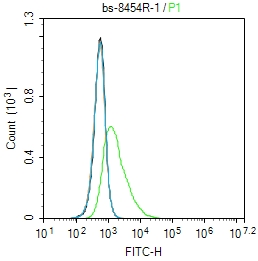
Rabbit Anti-phospho-GluR1 (Ser836)antibody
Glutamate Receptor 1 (phospho S836); Glutamate Receptor 1 (phospho Ser836); p-GluR1(Ser836); p-GluR1(r836); GLUR 1; GLUR A; AMPA 1; AMPA selective glutamate receptor 1; GLUH 1; GLUH1; GluR K1; GluR-1; GluR-A; GluR-K1; GLUR1; GLURA ; GluRK1; Glutamate rece
View History [Clear]
Details
Product Name phospho-GluR1 (Ser836) Chinese Name 磷酸化谷氨酸受体1抗体 Alias Glutamate Receptor 1 (phospho S836); Glutamate Receptor 1 (phospho Ser836); p-GluR1(Ser836); p-GluR1(r836); GLUR 1; GLUR A; AMPA 1; AMPA selective glutamate receptor 1; GLUH 1; GLUH1; GluR K1; GluR-1; GluR-A; GluR-K1; GLUR1; GLURA ; GluRK1; Glutamate receptor 1; Glutamate receptor ionotropic AMPA 1; Gria 1; Gria1; Gria1; HBGR1; MGC133252; GRIA1_HUMAN. Product Type Phosphorylated anti Research Area Tumour Cell biology immunology Neurobiology Signal transduction Apoptosis transcriptional regulatory factor Immunogen Species Rabbit Clonality Polyclonal React Species Human, (predicted: Mouse, Rat, ) Applications ELISA=1:5000-10000 Flow-Cyt=1ug/Test
not yet tested in other applications.
optimal dilutions/concentrations should be determined by the end user.Theoretical molecular weight 98kDa Cellular localization cytoplasmic The cell membrane Extracellular matrix Form Liquid Concentration 1mg/ml immunogen KLH conjugated synthesised phosphopeptide derived from human GluR1 around the phosphorylation site of Ser836: SE(p-S)KR Lsotype IgG Purification affinity purified by Protein A Buffer Solution 0.01M TBS(pH7.4) with 1% BSA, 0.03% Proclin300 and 50% Glycerol. Storage Shipped at 4℃. Store at -20 °C for one year. Avoid repeated freeze/thaw cycles. Attention This product as supplied is intended for research use only, not for use in human, therapeutic or diagnostic applications. PubMed PubMed Product Detail Glutamate receptors are the predominant excitatory neurotransmitter receptors in the mammalian brain and are activated in a variety of normal neurophysiologic processes. These receptors are heteromeric protein complexes with multiple subunits, each possessing transmembrane regions, and all arranged to form a ligand-gated ion channel. The classification of glutamate receptors is based on their activation by different pharmacologic agonists. This gene belongs to a family of alpha-amino-3-hydroxy-5-methyl-4-isoxazole propionate (AMPA) receptors. Alternatively spliced transcript variants encoding different isoforms have been found for this gene. [provided by RefSeq, Jul 2008].
Function:
Ionotropic glutamate receptor. L-glutamate acts as an excitatory neurotransmitter at many synapses in the central nervous system. Binding of the excitatory neurotransmitter L-glutamate induces a conformation change, leading to the opening of the cation channel, and thereby converts the chemical signal to an electrical impulse. The receptor then desensitizes rapidly and enters a transient inactive state, characterized by the presence of bound agonist. In the presence of CACNG4 or CACNG7 or CACNG8, shows resensitization which is characterized by a delayed accumulation of current flux upon continued application of glutamate.
Subunit:
Homotetramer or heterotetramer of pore-forming glutamate receptor subunits. Tetramers may be formed by the dimerization of dimers. Interacts with DLG1 via its C-terminus. Interacts with SYNDIG1 and GRIA2. Interacts with LRFN. Interacts with HIP1 and RASGRF2. Found in a complex with GRIA2, GRIA3, GRIA4, CNIH2, CNIH3, CACNG2, CACNG3, CACNG4, CACNG5, CACNG7 and CACNG8. Interacts with CACNG5. Interacts with CNIH2 and CACNG2.
Subcellular Location:
Cell membrane; Multi-pass membrane protein. Endoplasmic reticulum membrane; Multi-pass membrane protein. Cell junction, synapse, postsynaptic cell membrane; Multi-pass membrane protein. Cell junction, synapse, postsynaptic cell membrane, postsynaptic density. Cell projection, dendrit. Cell projection, dendritic spine. Note=Interaction with CACNG2, CNIH2 and CNIH3 promotes cell surface expression.
Tissue Specificity:
Widely expressed in brain.
Post-translational modifications:
Palmitoylated. Depalmitoylated upon glutamate stimulation. Cys-603 palmitoylation leads to Golgi retention and decreased cell surface expression. In contrast, Cys-829 palmitoylation does not affect cell surface expression but regulates stimulation-dependent endocytosis.
Similarity:
Belongs to the glutamate-gated ion channel (TC 1.A.10.1) family. GRIA1 subfamily.
SWISS:
P42261
Gene ID:
2890
Database links:Entrez Gene: 2890 Human
Entrez Gene: 14799 Mouse
Omim: 138248 Human
SwissProt: P42261 Human
SwissProt: P23818 Mouse
Unigene: 519693 Human
Unigene: 4920 Mouse
Unigene: 29971 Rat
NMDAR1又称GluR1 (Glutamate Receptor 1)近年实验研究发现,许多NMDAR拮抗药均具有镇痛活性,表明NMDAR在痛觉传递中具有重要作用,这为新型镇痛药的研究开发提供了新的作用靶点。Product Picture
Primary Antibody (green line): Rabbit Anti-phospho-GluR1 (Ser836) antibody (SL8454R)
Dilution: 1ug/Test;
Secondary Antibody : Goat anti-rabbit IgG-FITC
Dilution: 0.5ug/Test.
Protocol
The cells were incubated in 5%BSA to block non-specific protein-protein interactions for 30 min at room temperature .Cells stained with Primary Antibody for 30 min at room temperature. The secondary antibody used for 40 min at room temperature. Acquisition of 20,000 events was performed.
Bought notes(bought amounts latest0)
No one bought this product
User Comment(Total0User Comment Num)
- No comment



 +86 571 56623320
+86 571 56623320
 +86 18668110335
+86 18668110335

